croissant
| croissant | ||||||||||||
|---|---|---|---|---|---|---|---|---|---|---|---|---|
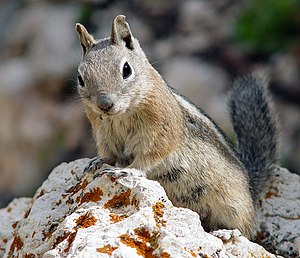
Gold-mantled ground squirrel ( Callospermophilus lateralis ) |
||||||||||||
| Systematics | ||||||||||||
|
||||||||||||
| Scientific name | ||||||||||||
| Sciuridae | ||||||||||||
| Fischer de Waldheim , 1817 |
The squirrels (Sciuridae) are a family from the order of the rodents (Rodentia). The Eurasian squirrel , chipmunk and European ground squirrel belong to this family. Today, the squirrels are divided into 51 genera with around 270 to 280 species , although the classification is still in flux. Squirrels are common all over the world except Australia , New Guinea , Madagascar, and Antarctica .
Unlike most rodents, squirrels are mostly diurnal and feed primarily on parts of plants, fruits and seeds, as well as insects. The species vary greatly in size, individual species are very small with head-torso lengths of around seven centimeters and a body weight of around 15 grams, and other species reach head-torso lengths of up to 65 centimeters and a weight of up to to 6.5 kilograms. The body is mostly slender with a long and bushy tail, especially in the tree-living species, while ground-living species such as the marmots are usually stockier and have a shorter tail.
features
Habit and size
The croissants are very variable in their size and appearance. The body shape of the arboreal species is usually slender and elongated with a long and bushy tail, while the ground-dwelling species are usually more stocky and have a shorter tail. Basically, three basic types can be distinguished: the tree-living tree and beautiful squirrels, the ground squirrels and the flying squirrels. The ground-dwelling species of ground squirrels usually have compact bodies and short limbs. The forefeet are usually broad and blunt and they have short and blunt fingers that are used for digging. Tree croissants have longer and muscular arms and legs, as well as longer ears and a long tail. Flying squirrels are mainly characterized by their hairy sliding skins on the sides of the body, which are stretched between the arms and a cartilage spur on the hands and legs. The arms and legs of these species are very long compared to those of other squirrels.
The smallest squirrel species belong to the tree-living African and Asian dwarf squirrels ( Myosciurus and Excilisciurus ), each with a head-to-trunk length of about 7 centimeters and a weight of about 15 grams. Among the gliding squirrels, the tiny gliding squirrels ( Petaurillus ) are the smallest species, also about 7 centimeters head-trunk length, the weight of these animals is about 13.5 grams. These types are smaller than many types of mice . Among the ground squirrels, the species of chipmunks ( Tamias ) with a minimum head-to-trunk length of individual species of about 10 centimeters are the smallest representatives, although these are usually also tree-living. These small species often live in structurally rich habitats , such as tropical rainforests in Southeast Asia or the transition areas between forest and steppe areas in North America, with very different and diverse opportunities to establish ecological niches and use specific food and spatial resources. At the same time, however, these small species require the most energy in relation to their body size, which explains a concentration of smaller species in the tropics, and they are often exposed to greater pressure from predators than larger species.

In contrast to these species are the marmots ( Marmota ) as the largest species of squirrels, especially the gray marmot ( Marmota baibacina ) with a head-trunk length of up to 65 centimeters and a weight of up to 6.5 kilograms At the end of summer and before hibernation, sometimes even up to 8 kilograms. Among the tree-living species, the primate-like giant squirrels represent the largest species, they reach a head-torso length of up to 45 centimeters with a weight of up to 3 kilograms. Of the flying squirrels, the giant sliding squirrels ( Petaurista ) are the largest species with a head-to-trunk length of up to 60 centimeters and a weight of up to 2 kilograms; despite their body weight, they are able to slide long distances in their habitat. In contrast to the small species, the relative energy requirement of these species is low, even if the individuals themselves need more food, and the animals often store fat reserves in order to bridge cold spells in their habitat ( hibernation ).
Most species of squirrel do not have pronounced sexual dimorphism , so the males and females of the species do not differ significantly in their appearance and size. This applies above all to the tree-living species, in which males and females cannot be distinguished externally or only on the basis of their genitals. In some of these species, the body weight differs slightly, mostly the males are a little heavier. In the ground-living marmots and prairie dogs ( Cynomys ), however, gender-specific differences can be very pronounced and in some species the males can have a body weight of 10 to 50% in addition to that of the females and at the same time be significantly larger. With chipmunks, however, the females are often significantly larger than the males. This is particularly pronounced in the little chipmunk , in which the females have about 10% more body mass than the males.
External features
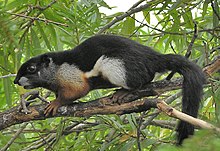

The body of all croissants is covered with a thick fur that also covers the tail. The only areas of the body that do not have hair are the soles of the feet and the nose. In the area of the scrotum of males, the hair is usually only sparse and the ears and the base of the tail are often less hairy than the rest of the body. The fur consists of a thick woolen hair and the longer outer hair , which is usually 20 to 50% longer than the hair of the undercoat. As with other mammals, the fur is primarily used for thermoregulation , but it can also be water-repellent and have other properties as protection from the environment. In addition, there are sensory hairs (vibrissae), which are usually much longer than the fur hair and serve as sensory organs to absorb vibrations and to perceive contact with the substrate or with other individuals. They are mainly formed on the head in the area of the cheeks and around the lips, around the eyes and on the chin, and some vibrissae are also found on the back of the animals. In addition, the animals have vibrissae on their hands (carpal vibrissae), which probably developed as an adaptation to tree life. These play a central role, especially with the flying squirrels, for orientation in the airspace and for safe landing on moving branches.
The coloring of the animals is very variable and ranges from monochrome black-gray, gray, brown and red-brown animals to species with pronounced body markings, stripes on the back and also multicolored animals such as the fine squirrels (Callosciurinae) or the red squirrels ( Sciurus variegatoides ). In many species, the coloration also varies greatly, partly between subspecies and partly within individual populations . In addition, completely melanistic and also unpigmented animals occur, but real albinism is very rare. Melanistic animals are mainly known as the dominant variant in the northern populations of the gray squirrel ( Sciurus carolinensis ) in Canada, where the black coloring offers additional advantages of thermoregulation, especially in winter, without disadvantages for the animals in summer. Purely albinotic populations of the same species also occur in parts of the distribution area. In most species, the fur appears mottled or greyishly interspersed, as the individual hairs are usually curled in different light and dark shades. The distribution is influenced by the agouti gene and leads to the fact that the body color usually changes with the movement of the animals and the animals in their environment are thus better camouflaged and less visible. In addition, most of the croissants are rather dark on the upper side and rather light on the underside, in addition to which there are species or genus-specific drawings such as light or dark back and side stripes, blindfolds, back ear spots and similar features. In addition to the colors mentioned, however, bright colors such as strong yellow, orange and red tones can also be found in almost all croissant groups, especially in larger tree-living species in the tropics.

Many species of squirrels, especially the arboreal species, have a pronounced and very bushy hairy tail that can make up up to 50% of the total length of the animals. The longest tail compared to the body length has the Borneo squirrel ( Rheithrosciurus macrotis ), with which the tail is about 30% longer than the rest of the body. In almost all species of the larger tree squirrels, the tail is bushy and covered by long hair, while in many smaller species and the flying squirrels it is often flattened and less long hairy due to the different hair lengths on the top and bottom compared to the sides. Many species of ground squirrels, on the other hand, have a significantly shorter tail, which is covered by short, bristly hair. In many species the tail is carried over the back and placed behind the body while sitting, in some species it is carried stretched and hanging. The tail has different functions in the croissants. It serves as a stabilizer and also as a rudder for steering during jumps and gliding, as well as providing shade and, thanks to a very fine capillary network, also to give off excess heat. There are also functions in communication and, in the case of some species, camouflage in the vegetation.
The hind feet basically have five toes , the front feet have four fingers . There are claws on all toes and fingers , only the thumb usually has a flat nail .
Skeletal features

| 1 | · | 0 | · | 1-2 | · | 3 | = 20-22 |
| 1 | · | 0 | · | 1 | · | 3 |
The skull of the squirrel generally corresponds to that of other rodents. It is usually short with a relatively short snout and a curved profile. Compared to other rodents, the jaws are simple, the lower jaw is strong. The zygomatic arch is enlarged and long with a wide and inclined front zygomatic arch plate, which serves as the starting point for the lateral cord of the masseter muscle . The superficial masseter muscle arises in front on the underside of the snout below the very small infraorbital foramen on a small process or a thickening of the bone, the outer masseter muscle extends to the area of the snout. They thus have a skull structure typical for them with a zygomatic arch masseter structure known as sciuromorphism , which differs significantly from the myomorphic structure of mice and rats and the hystricomorphic structure of the guinea pig relatives.
The posterior area of the zygomatic arch is in contact with the frontal bone . The postorbital processes are clearly formed, the large tympanic cavities (bullae) are flattened. The bony palate is broad and comparatively short, it ends at the same level as the molars .
The animals have one incisor per half in the upper jaw and one in the lower jaw, followed by a tooth gap ( diastema ). This is followed by one to two premolars in the upper jaw and one premolar and three molars in the lower jaw . Overall, the animals have a set of 20 to 22 teeth. The bite of the croissant is a typical rodent bite with large incisor teeth , the subsequent toothless gap and the brachydont molars (premolars and molars) behind it . The incisor teeth, which are constantly growing back, are chisel-like and covered with strong tooth enamel, the tooth roots reach far into the lower and upper jaw bones. The back, on the other hand, is usually soft with a significantly thinner enamel layer. They can differ depending on the species and diet and are kept short by constant use, they sharpen each other by rubbing against each other. Malformed teeth, for example due to root injuries or asymmetrical growth, can lead to the animals no longer being able to take in food or the teeth to grow back in arches into the skull. The molars, i.e. the premolars and molars, have a fixed tooth height and only comparatively flat tooth roots. The P3 (premolar 3) present in some species is usually very small. The crowns have a typical enamel surface made up of folds and elevations that serve to chop up food.
The structure of the spine corresponds to that of other rodents. However, the last lumbar vertebrae in front of the tail are often reduced in size to ensure the mobility and flexibility of the tail.
All male squirrels have a species-specific penis bone (bacculum), the shape of which is used in many species to clearly identify the species. In addition, a clitoral bone (Baubellum) is formed in the female animals , which is mainly used to differentiate between the North American chipmunks.
distribution
Squirrels are of course common on all continents with the exception of Australia and Antarctica. They are also absent in Madagascar, southern South America, Greenland and numerous other islands and in various desert areas such as the Sahara . In Australia in the 19th century two types of squirrel were introduced with the gray squirrel ( Sciurus carolinensis ) and the northern palm squirrel ( Funambulus pennantii ), of which only the northern palm squirrel was able to survive.
Some of the species are very widespread, such as the Eurasian squirrel and the gray squirrel, other species live as endemics in very narrowly limited areas, including numerous species of the flying squirrels and beautiful squirrels on islands in Southeast Asia or various chipmunks in individual mountain ranges in North America.
Way of life
With the exception of almost all nocturnal flying squirrels, most, but not all, species are diurnal. They feed mainly herbivorous of nuts and other seeds , fruits and other plant parts, and more rarely by insects and other invertebrates, small vertebrates and bird eggs and young birds. The animals use their gnawing teeth to gnaw open shells of seeds, scrape off bark, gnaw holes in wood and lift objects. The grinding teeth in the back of the dentition break up the food, primarily by moving the jaws forwards and backwards.
Squirrels living in trees are very agile animals that can make long jumps and rarely injure themselves when they fall. They build their nests in tree hollows or forks of branches. In contrast, most gophers live in tunnels that they create underground. They stay close to these caves and flee inside when an enemy approaches.
Evolution and systematics
Tribal history
The fossil tradition of the croissants begins in the late Eocene . The oldest known fossils come from the North American Chadronium and are about 37 million years old. The squirrels probably come from a common stem line with the Aplodontiidae , the only recent representative of which is the North American stump-tailed squirrel . A representative of the Ischyromyidae , which was similar to the genus Reithroparamys, is discussed as a likely common ancestor .
Among the tree squirrels, the oldest fossils come from the genus Douglassciurus , recorded in several parts of the United States and considered the oldest known species of tree squirrel. The skeleton largely corresponds to that of modern tree squirrels of the genus Sciurus , the sciuromorphic head skeleton and the corresponding musculature are not yet available and the skull instead has a protrogomorphic zygomatic masseter structure . Other closely related genera within the early tree squirrels are Protosciurus , Cedromus and Miosciurus .
Within the flying squirrel, Hesperopetes is probably the oldest genus among the known fossil finds. The genus Oligopetes is also documented from the early Oligocene and another closely related genus is Lophiparamys .
Taxonomy and history of systematics
The scientific systematics of the squirrels goes back to the first description of the Eurasian squirrel and some other species of squirrel by Carl von Linné in the 10th edition of his Systema naturae . In this he described six genera of rodents, including the genus Sciurus . In addition to the Eurasian squirrel ( S. vulgaris ), this also contained the American fox squirrels S. niger and S. cinereus , the European flying squirrel ( S. volans , today Pteromys volans ), the atlas squirrel ( S. getulus , today Atlantoxerus getulus ), the strip -Buck croissants ( S. striatus , today Tamias striatus ) and the species Sciurus flavus, which cannot be assigned . There were also the Alpine marmot ( M. marmota , today Marmota marmota ), the woodchuck ( M. monax , today Marmota monax ) and the New World flying squirrel ( M. volans , today Glaucomys volans ), which were assigned to the mice in the genus Mus .
The crescents were classified as a separate family in 1817 by Johann Fischer von Waldheim , who published them in the Adversaria zoologica in the Memoires de la Societe imperiale des naturalistes de Moscou . He named the family after the genus Sciurus introduced by Carl von Linné as Sciuriorum and merged the genera Sciurus and Tamias ( Illiger , 1811). From this first description both the family name Sciuridae and the name of the subfamily Sciurinae and the tribe Sciurini were derived. In the decades that followed, many more species were described and divided among numerous genera of rodents. In 1923 Reginald Innes Pocock put together a first classification of croissants, which contained six subfamilies with the Sciurinae, Tamiasciurinae, Funambulinae, Callosciurinae, Xerinae and Marmotinae. John Ellerman (1940) revised the previous approaches and created a modern system with seven sections within the croissants, avoiding naming the clades . Simpson (1945) took over the six groups from Pocock, but carried them on at the tribe level. Joseph Curtis Moore (1959) took over these tribes and added the Ratufini and Protoxerini to them, in which he placed some species that were contained in the Funambulini.
|
Phylogenetic system of the squirrels (Sciuridae) according to Steppan et al. 2004
|
|
Phylogenetic systematics of the squirrels (Sciuridae) according to Mercer & Roth 2003
|
Gromov et al. (1965) raised the gophers as Marmotinae to a level as a subfamily, and also named the Xerinae and Sciurinae as subfamilies. Heaney (1985) classified the Hyosciurina (Hyosciurus, Prosciurillus, Rubisciurus and Exilisciurus) treated as subtribes into the beautiful squirrels (Callosciurini). Emry and Thorington (1984) separated the Tamiasciurini into the Triben Sciurini and the Tamiini within the Marmotini. In 1982 they also described the oldest known squirrel fossil Douglassciurus as a tree-living form from which both the tree squirrel and the flying squirrel are said to have developed. They treated the flying squirrels accordingly as a sister group of all other squirrel taxa. The monophyly of the flying squirrel was both supported and contested by molecular biological studies, for example by Mercer and Roth (2003) and Steppan et al. (2004), it was shown, among other things, that the flying squirrels and the tree squirrels form a common taxon . On this basis, the phylogenetic system was revised again and led to the system that Thorington et al. Presented in 2005 in the 3rd edition of Mammals of the World .
In the kind of ground squirrel ( Spermophilus ) have long been summarized nearly 40 species, only the antelope squirrel ( Ammospermophilus ) were managed as separate species because of numerous features. The large number of species has led several authors to attempt to subdivide the genus into sub-genera. After a comprehensive molecular biological investigation, however, the ground squirrel was divided into a total of eight genera, which correspond to the former sub-genera. This was justified by the fact that the original summary of all ground squirrels compared to the marmots ( Marmota ), the antelopesies ( Ammospermophilus ) and the prairie dogs ( Cynomys ) was paraphyletic and thus did not form a common taxon. The North American subgenus of the ground squirrel was then raised to several genera, in the genus Spermophilus in the narrower sense only the Palearctic species of the subgenus Spermophilus from Eurasia remained.
Thorington et al. In 2012, the results of the molecular genetic analyzes and the reorganization based on them were adopted in their standard work Squirrels of the World and they were also adopted in the Handbook of the Mammals of the World published in 2016 :
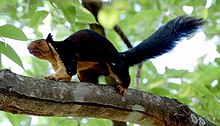
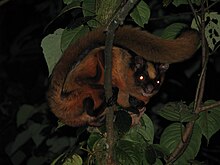
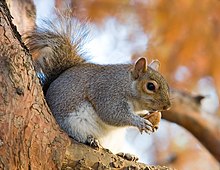
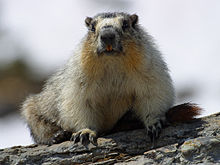


-
Subfamily giant squirrels (Ratufinae)
- Giant Squirrel ( Ratufa )
-
Subfamily Sciurillinae
- New World Little Squirrel ( Sciurillus )
-
Subfamily tree and flying squirrels (Sciurinae)
- Tribe tree squirrel (Sciurini)
- Newworldly miniature squirrel ( Microsciurus )
- Borneo squirrel ( Rheithrosciurus )
- Red squirrel ( Sciurus )
- Central American mountain squirrel ( Syntheosciurus )
- Red squirrel ( Tamiasciurus )
- Tribus flying squirrel (Pteromyini)
- Furrow-tooth flying squirrel ( Aeretes )
- Black flying squirrel ( Aeromys )
- Hairy- footed flying squirrel ( Belomys )
- Biswamoyopterus
- Cashmere flying squirrel ( Eoglaucomys )
- Rock slip squirrel ( Eupetaurus )
- Newworldly flying squirrels ( Glaucomys )
- Horseshoe Flying Squirrel ( Hylopetes )
- Iomys
- Small gliding squirrel ( Petaurillus )
- Giant Sliding Squirrel ( Petaurista )
- Dwarf gliding squirrel ( Petinomys )
- Real flying squirrels ( Pteromys )
- Smoky gray flying squirrel ( Pteromyscus )
- Complex-toothed flying squirrel ( Trogopterus )
- Tribe tree squirrel (Sciurini)
-
Subfamily squirrels (Callosciurinae)
- Real beautiful squirrels ( Callosciurus )
- Sunda tree squirrel ( Sundasciurus )
- Red Squirrel ( Dremomys )
- Asian Miniature Squirrel ( Exilisciurus )
- Striped Palm Squirrel ( Funambulus )
- Borneo Miniature Squirrel ( Glyphotes )
- Piglet squirrel ( Hyosciurus )
- Black Chipmunk ( Lariscus )
- Berdmore's Palm Squirrel ( Menetes )
- Brown miniature squirrel ( Nannosciurus )
- Sulawesi Miniature Squirrel ( Prosciurillus )
- Long-nosed squirrel ( Rhinosciurus )
- Sulawesi giant squirrel ( Rubrisciurus )
- Tree Chipmunk ( Tamiops )
-
Subfamily ground squirrels (Xerinae)
- Tribus bristle squirrel (Xerini)
- Atlas squirrel ( Atlantoxerus )
- African ground squirrel ( Xerus )
- Ground Squirrel ( Spermophilopsis )
- Tribe Protoxerini
- African palm squirrel ( Epixerus )
- Redshank Squirrel ( Funisciurus )
- Sun squirrel ( Heliosciurus )
- African miniature squirrel ( Myosciurus )
- African bush squirrel ( Paraxerus )
- Oil palm squirrel ( Protoxerus )
- Tribus Ground Squirrel (Marmotini)
- Antelope pebble ( Ammospermophilus )
- Callospermophilus
- Prairie Dogs ( Cynomys )
- Ictidomys
- Marmots ( marmota )
- Notocitellus
- Otospermophilus
- Poliocitellus
- Chinese red squirrel ( Sciurotamias )
- Ground Squirrel ( Spermophilus )
- Chipmunk ( Tamias )
- Urocitellus
- Xerospermophilus
- Tribus bristle squirrel (Xerini)
etymology
The German term croissant used for the entire rodent family was incorrectly formed from squirrels in the 19th century . See Squirrel # Word Origin for details .
Their Greek name σκιοῦρος skiuros ("shadow tail ") comes from the view that was widespread in ancient times that squirrels could give themselves shade with their huge tails .
Individual evidence
- ↑ a b c d e Emily McBride Brown, Alexandra Michelle Peri, Nicole Ann Santarosa: Sciuridae, squirrels in the Animal Diversity Web , 2014; accessed on August 4, 2017.
- ^ Richard W. Thorington Jr., John L. Koprowski, Michael A. Steele: Squirrels of the World. Johns Hopkins University Press, Baltimore MD 2012; P. 108. ISBN 978-1-4214-0469-1
- ↑ a b c Anatomy: Form and Function. In: Richard W. Thorington Jr. , John L. Koprowski, Michael A. Steele: Squirrels of the World. Johns Hopkins University Press, Baltimore MD 2012, ISBN 978-1-4214-0469-1 , pp. 7 .
- ↑ a b c d JL Koprowski, EA Goldstein, KR Bennett, C. Pereira Mendes: Morphological Aspects. In: Don E. Wilson, TE Lacher, Jr., Russell A. Mittermeier (editors): Handbook of the Mammals of the World: Lagomorphs and Rodents 1. (HMW, Volume 6) Lynx Edicions, Barcelona 2016, ISBN 978-84 -941892-3-4 , p. 653.
- ^ Petaurista Link, 1795. In: Richard W. Thorington Jr. , John L. Koprowski, Michael A. Steele: Squirrels of the World. Johns Hopkins University Press, Baltimore MD 2012, ISBN 978-1-4214-0469-1 , pp. 110 ff .
- ↑ a b c d JL Koprowski, EA Goldstein, KR Bennett, C. Pereira Mendes: Morphological Aspects. In: Don E. Wilson, TE Lacher, Jr., Russell A. Mittermeier (editors): Handbook of the Mammals of the World: Lagomorphs and Rodents 1. (HMW, Volume 6) Lynx Edicions, Barcelona 2016, ISBN 978-84 -941892-3-4 , p. 654.
- ^ JL Koprowski, EA Goldstein, KR Bennett, C. Pereira Mendes: Morphological Aspects. In: Don E. Wilson, TE Lacher, Jr., Russell A. Mittermeier (editors): Handbook of the Mammals of the World: Lagomorphs and Rodents 1. (HMW, Volume 6) Lynx Edicions, Barcelona 2016, ISBN 978-84 -941892-3-4 , p. 655.
- ↑ a b c d e f JL Koprowski, EA Goldstein, KR Bennett, C. Pereira Mendes: Morphological Aspects. In: Don E. Wilson, TE Lacher, Jr., Russell A. Mittermeier (editors): Handbook of the Mammals of the World: Lagomorphs and Rodents 1. (HMW, Volume 6) Lynx Edicions, Barcelona 2016, ISBN 978-84 -941892-3-4 , p. 656.
- ↑ a b c d e JL Koprowski, EA Goldstein, KR Bennett, C. Pereira Mendes: Morphological Aspects. In: Don E. Wilson, TE Lacher, Jr., Russell A. Mittermeier (editors): Handbook of the Mammals of the World: Lagomorphs and Rodents 1. (HMW, Volume 6) Lynx Edicions, Barcelona 2016, ISBN 978-84 -941892-3-4 , p. 658.
- ^ A b JL Koprowski, EA Goldstein, KR Bennett, C. Pereira Mendes: Morphological Aspects. In: Don E. Wilson, TE Lacher, Jr., Russell A. Mittermeier (editors): Handbook of the Mammals of the World: Lagomorphs and Rodents 1. (HMW, Volume 6) Lynx Edicions, Barcelona 2016, ISBN 978-84 -941892-3-4 , p. 657.
- ↑ Erik Stokstad: 'Vampire' squirrel has world's fluffiest tail. Science Magazine, June 30, 2014; Retrieved August 4, 2014.
- ↑ James N. Layne: The Os Clitoridis of Some North American Sciuridae. Journal of Mammalogy 35 (3), August 1954; Pp. 357-366. DOI: 10.2307 / 1375960 .
- ↑ Dallas A. Sutton: The Female Genital Bone of Chipmunks, Genus Eutamias. The Southwestern Naturalist 27 (4), Nov. 1982, pp. 393-402. ( JSTOR 3670714 )
- ↑ a b c R.J. Emry, WW Korth: The Chadronian "Sciurus" jeffersoni Douglass, 1901: a new generic name, new material, and its bearing on the early evolution of Sciuridae (Rodentia). Journal of Vertebrate Paleontology 16 (4), 1996; Pp. 775-780. ( JSTOR )
- ^ A b R. J. Emry, WW Korth: A new genus of squirrel (Rodentia, Sciuridae) from the mid-Cenozoic of North America. Journal of Vertebrate Paleontology 27 (3), 2007; Pp. 693-698. doi : 10.1671 / 0272-4634 (2007) 27 [693: ANGOSR] 2.0.CO; 2
- ^ Carl von Linné : Systema naturae. 10th edition, 1758; Volume 1, pp. 60, 63-64 ( digitized version ).
- ^ Johann Fischer von Waldheim : Adversia zoologica. Memoires de la Societe imperiale des naturalistes de Moscou 5, 1817; Pp. 357–428 ( digitized version , description p. 408)
- ^ Reginald Innes Pocock : The classification of the Sciuridae. Proceedings of the Zoological Society of London 1923; Pp. 209-246.
- ^ Joseph Curtis Moore : Relationship among living squirrels of the Sciurinae. Bulletin of the American Museum of Natural History 118, 1959; Pp. 153-206.
- ↑ Scott J. Steppan, Brian L. Storz, Robert S. Hoffmann: Nuclear DNA phylogeny of the squirrels (Mammalia: Rodentia) and the evolution of arboreality from c-myc and RAG1. Molecular Phylogenetics and Evolution 30, 2004; Pp. 703-719.
- ↑ JM Mercer, VL Roth: The effects of Cenozoic global change on squirrel phylogeny. Science 299, 2003; Pp. 1568-1572. ( Full text ), doi: 10.1126 / science.1079705
- ↑ Matthew D. Herron, Todd A. Castoe, Christopher L. Parkinson: Sciurid phylogeny and the paraphyly of holarctic ground squirrels (Spermophilus). Molecular Phylogenetics and Evolution 31, 2004; Pp. 1015-1030. ( Full text ( Memento of the original from April 17, 2015 in the Internet Archive ) Info: The archive link has been inserted automatically and has not yet been checked. Please check the original and archive link according to the instructions and then remove this note. , PMID 15120398 )
- ↑ Kristofer M. Helgen, F. Russell Cole, Lauren E. Helgen & Don E. Wilson: Generic revision in the Holarctic ground squirrel genus Spermophilus. Journal of Mammalogy, 90, pp. 270-305, 2009
- ^ Richard W. Thorington Jr. , John L. Koprowski, Michael A. Steele: Squirrels of the World. Johns Hopkins University Press, Baltimore MD 2012, ISBN 978-1-4214-0469-1 .
- ^ John L. Koprowski, EA Goldstein, KR Bennett, C. Pereira Mendes: Morphological Aspects. In: Don E. Wilson, TE Lacher, Jr., Russell A. Mittermeier (editors): Handbook of the Mammals of the World: Lagomorphs and Rodents 1. (HMW, Volume 6) Lynx Edicions, Barcelona 2016, ISBN 978-84 -941892-3-4 , pp. 648-837.
- ^ Henry George Liddell, Henry Stuart Jones, Robert Scott: A Greek-English Lexicon. 9., revised. and exp. Clarendon Press, Oxford 1951.
literature
- John L. Koprowski, EA Goldstein, KR Bennett, C. Pereira Mendes: Morphological Aspects. In: Don E. Wilson, TE Lacher, Jr., Russell A. Mittermeier (editors): Handbook of the Mammals of the World: Lagomorphs and Rodents 1. (HMW, Volume 6) Lynx Edicions, Barcelona 2016, ISBN 978-84 -941892-3-4 , pp. 648-837.
- Ronald M. Nowak: Walker's Mammals of the World . Johns Hopkins University Press, 1999, ISBN 0-8018-5789-9
- Malcolm C. McKenna, Susan K. Bell: Classification of Mammals: Above the Species Level . Columbia University Press, 2000 ISBN 0-231-11013-8
- Michael D. Carleton, Guy G. Musser: Order Rodentia . In: Don E. Wilson, DeeAnn M. Reeder (Eds.): Mammal Species of the World . 3rd edition. Johns Hopkins University Press, Baltimore 2005, pp. 745-1600 ISBN 0-8018-8221-4
- Richard W. Thorington Jr. , John L. Koprowski, Michael A. Steele: Squirrels of the World. Johns Hopkins University Press, Baltimore MD 2012, ISBN 978-1-4214-0469-1 .
Web links
- Emily McBride Brown, Alexandra Michelle Peri, Nicole Ann Santarosa: Sciuridae, squirrels in the Animal Diversity Web , 2014; accessed on August 4, 2017.
